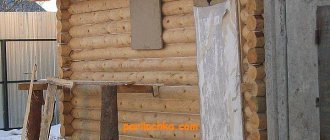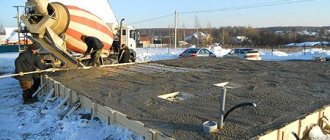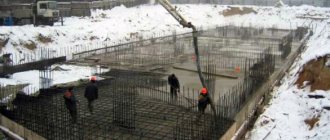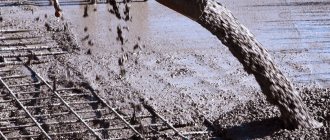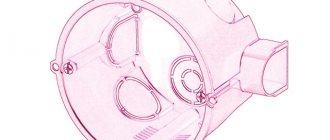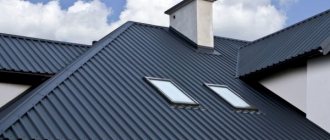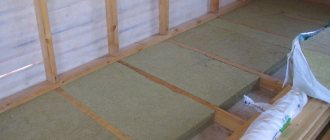Traditionally, “wet” processes include all activities related to the construction of buildings and structures that are associated with concreting, masonry work, plastering, etc. One of the main components necessary for preparing concrete mixtures and solutions directly on the construction site is water, which freezes at subzero temperatures.
In this part of the training course, we will talk about what nuances need to be taken into account when carrying out “wet” work in winter and how to properly use antifreeze additives.
Are there any advantages to winter concrete work?
In general, working with concrete in harsh conditions of low temperatures entails additional difficulties, but it is impossible to stop construction for six months every time autumn comes, and besides, winter work also has significant advantages:
- Winter discounts on building materials and the decline in demand for labor make it possible to save money.
- In winter, foundations can be concreted on weak or brittle soil.
- Frozen access roads make it possible to easily deliver heavy equipment and materials to a construction site.
The nuances of using antifreeze additives
It was already mentioned above that SP 70.13330 regulates the use of antifreeze additives. The fact is that antifreezes contain salts, and some additives, due to the presence of chlorides, can cause serious corrosion of steel reinforcement.
Each manufacturer has its own selection of additive components, but the main thing that a developer should remember when purchasing antifreeze additives is that he must choose a quality product from a well-established manufacturer. It should be written on the product packaging that the use of anti-frost additives in reinforced concrete structures is allowed.
Kirill Lebedev
If anti-frost additives are not used correctly in masonry mortars, in the spring, white stains (efflorescence) may appear on the facing brickwork. Therefore, you should strictly adhere to the manufacturer’s recommendations and use the dosage of antifreeze in strict accordance with the instructions.
Conclusions: The use of anti-frost additives ensures the continuity of the construction process at any external temperature and guarantees the quality and long service life of a country house. Although negative temperatures lead to increased costs associated with shorter working hours, additional costs for lighting, the need to heat workers and structures, etc., in winter prices for building materials, construction services, and equipment rentals decrease slightly. The cost of additives in the overall estimate for building a house is small. Therefore, with a competent approach, it is possible to bring the price of construction in winter and the price of construction in summer to a common denominator.
Features of winter concreting
In winter, the main enemy of high-quality concreting is low temperatures, which have a negative impact on the processes occurring both during concreting and during concrete hardening.
The formation of a solid substance - concrete - occurs as a result of the hydration reaction of the minerals that make up Portland cement. For this reaction to take place, a temperature above 0°C is necessary, since at negative temperatures water freezes and the hydration reaction stops.
Already at temperatures below 5°C, the reaction rate sharply slows down, and the strength gain of concrete slows down.
Low temperatures cause the following problems:
- cessation of the hydration reaction;
- increase in internal pressure due to freezing and associated expansion of the material;
- the formation of ice crystals around the reinforcement, which leads to poor adhesion to concrete;
- obtaining low-strength concrete.
The main task in winter is to ensure that the concrete reaches critical strength (30–50% of the design strength), after which negative temperatures no longer have a negative impact on concrete. Typically, under optimal conditions, critical strength is achieved 4–6 days after installation.
Therefore, in winter, temperature becomes of primary importance.
The temperature of the concrete mixture is measured before, during and after placement.
Important!
For winter concreting, it is recommended to use Portland cements and high-quality quick-hardening cements.
A set of concrete care measures
The finished mixture begins to harden after pouring into a mold or trench, and lasts approximately 28 days. During this time, it gains strength and requires careful treatment. The process of maintenance and protection includes a number of measures, we list them:
- protection against rapid drying;
- ensuring the required temperature;
- exclude physical impact;
- prevent the influence of the external environment - sun, frost, rain, snow;
- protect the water in it from freezing;
- provide hydration in sub-zero temperatures.
The optimal temperature for gaining strength is 20 degrees, air humidity 80%.
Warmhouses to protect concrete - you can build even in cold weather
Over most of Russia, winter reigns for 6 months a year, significantly shortening the period suitable for construction. The main problem that prevents the construction of high-rise buildings in the cold season is the inability to provide concrete (foundations, screeds) with optimal conditions for setting and gaining strength. In accordance with established practice and building regulations, after pouring the cement-sand mixture, the ambient temperature should not fall below +20 0 C. But no one will stop work because of cold weather, the onset of autumn or winter. What should those who are forced to lay the foundation in January or December do? At the first stage, let's find out why pouring concrete at sub-zero temperatures is undesirable? The main reason is a large amount of water, without which the mixture will not be fluid and will not fill existing voids. If the ambient temperature drops below 0C, the familiar liquid transforms into a different state of aggregation, becomes ice and expands. The process of gaining strength is suspended or stops completely. If it's -4C outside, the concrete begins to freeze. When warming or a thaw occurs, the ice melts, returns to its original state, and the process of hardening of the screed resumes. It will not be possible to achieve the required strength.
Warming up concrete in winter To prevent negative temperatures from affecting hardening, it is necessary to create certain conditions using one of the methods listed below:
- modifiers are added to the solution to change the physical and chemical properties of concrete;
- electric heating;
- using hot water to prepare concrete;
- installation of greenhouses around the formwork and on top of the screed.
Next, let's look at the advantages and disadvantages of each option.
Use of additives and modifiers
Frost-resistant additives are designed to reduce the time it takes for concrete to gain strength. Manufacturers and sellers report that the foundation will not differ in strength from what is poured in the summer, that the water simply will not have time to freeze. Practice often differs from theory. If we talk about the disadvantages, it is important to highlight the following:
- limited temperature range of action. Additives will help if the air outside has not yet cooled below -50C. In severe frosts there is no need to talk about the effectiveness of the method.
- The reinforcement corrodes, quickly oxidizes and collapses. Adhesion to concrete deteriorates, the foundation becomes less reliable.
Electric heating as a way to fill screeds in winter
The most common options for winter heating of concrete are:
- current is passed through electrodes used as reinforcement;
- Before pouring the mixture, a special heating cable is laid.
The first option assumes that current from a welding machine or special equipment is connected to the laid reinforcement mesh. Voltage - 127 V (no more). If the foundation or screed is laid unreinforced, or fiberglass is used, special electrodes are introduced into the solution, and the current strength is increased to 380 V.
Electric heating as a way to protect concrete in winter. The second method leads to a significant increase in the cost of the project, since a special heating cable is laid along the entire reinforcing mesh, connected to a source of electricity. But it is important to recognize that the efficiency is higher in comparison with the first option. The main disadvantage of heating with electricity is that you will not be able to plug the equipment into an outlet once and calmly wait 30 days until the base gains strength. You will have to constantly monitor the temperature, which is difficult with a large foundation area. The likelihood of the surface layer drying out increases.
Using hot water to make concrete
Another way to pour concrete in winter conditions is to preheat the water to 60-70C. The advantages include the opportunity to obtain a high-quality base without additional costs. But there are much more problems:
- it is difficult to calculate the correct temperature taking into account the climatic characteristics of the region;
- The method only works in mild frost. If the thermometer shows -10C or lower, the effect will quickly disappear;
- It is difficult to prepare large volumes of concrete. The heated mixture is good for building a small private house, but not an industrial workshop.
The installation of heat guns or special greenhouses - awnings or canopies - will help solve all the problems described earlier. Supplying heat is a very expensive proposition. You will have to pay the same amount for electricity, gas or diesel fuel per month as the foundation itself costs.
Warmhouses made from canopies and awnings
A temporary tent made of special insulated fabric (PVC, Oxford, tarpaulin) is erected over the construction site. If the foundation is of significant size, the awning is installed sequentially over the areas under work. For small construction sites, the greenhouse is mounted above the entire facility. This allows you not to worry about uneven setting of concrete or subsidence of individual sections. The advantages of greenhouses made from awnings and canopies include:
- reusable. As soon as the concrete gains strength, the awning or canopy is removed and transported to another facility. For example, it will not be possible to remove the heating cable. The installation/dismantling operation of the structure requires 5-6 hours depending on the volume;
- maintaining uniform temperature and humidity throughout the entire perimeter.
Tarpaulin with a density of 180 g/m2 for the installation of shelters for pouring concrete Let's consider the main types of greenhouses used on construction sites.
Warehouses from Tarpaulin: advantages and disadvantages
Tarpaulin thermomats are most in demand in the construction of greenhouses. The base is isolon, protected from external influences by layers of laminated polyethylene. To counteract ultraviolet radiation, a light-stabilizing film is applied to the outer surfaces. The advantages of tarpaulin greenhouses include:
- the ability to maintain a single microclimate in a closed space with thermometer readings in the range from -40C to +80C. You can save on installing additional heat guns or roasters;
- moisture and vapor tightness. Tarpaulin, manufactured in accordance with GOST, can withstand up to 1000 mm of water column. Water, snow, and fog from the street do not penetrate inside the greenhouse;
- resistance to rot and mold for a long time;
- light weight (lighter than tarpaulin). No heavy frame is required; light guides are sufficient;
- elasticity. You can create structures of any shape without any problems. There are no stretch marks or deformed areas;
- minimum price among analogues;
- Easy to clean from dirt and dust. Small stains are removed with a sponge; for “general” cleaning, a hose connected to the water supply is used.
In fairness, it is necessary to note the relative disadvantages of tarpaulin greenhouses:
- An additional problem is that with regular use, the edges of thermomats fray. They have to be additionally glued or sheathed.
The assortment includes tarpaulin in blue, blue-green, yellow, black and white colors. It is possible to choose the best option based on size and type of connection of individual panels.
Warmhouses made of tarpaulin
For production, a special three-layer material is used. The top and bottom layers are tarpaulin made of linen or cotton fibers. Medium - isolon (sintepon). The advantages of tarpaulin greenhouses include:
- maintaining the temperature inside the “room” even with a sharp drop in temperature down to -60C;
- wear resistance and increased strength. Tarpaulin curtains do not lose their performance even after 5 years. Cuts can be easily repaired with patches that do not create cold bridges;
- the use of special impregnations avoids the formation of mold, rot, fungus, and protects against fire;
- water- and dirt-repellent properties. A water column thickness of up to 1000 mm will not harm the material and the structure as a whole.
Among the disadvantages of canvas greenhouses, we highlight:
- high density (up to 650 g/m2). The awning or canopy turns out to be quite heavy. In practice, this means special requirements for fastenings.
- this “point” is significant for aesthetes. The color range of the material is inexpressive and is limited to black and khaki variations.
In the assortment you can buy tarpaulin canopies with additional anti-rot impregnation, manufactured in accordance with the standards.
Oxford fabric warmers
Oxford awnings are made from particularly durable synthetic fabric (polyester or nylon).
A hydrophilic membrane is applied to protect against water. The middle layer is padding polyester with a thickness of 5 to 25-30 mm (thermal mats). Warm houses made from Oxford fabric The advantages of warm houses made from Oxford include:
- ability to withstand temperatures down to -60C;
- water- and dirt-repellent properties. No special effort is required for care. Dust, clay, dirt can be washed off with water from a hose.
But Oxford has many more shortcomings. And you need to know about them:
- to protect against external influences, the fabric is treated with either polyvinyl chloride (PVC) or polyurethane (PU). In the first case, the material becomes more rigid and more difficult to roll and store. The second treatment option gives Oxford greater flexibility and water-repellent properties;
- The greenhouses do not allow air and steam to pass through. Water evaporating from the concrete screed remains inside; a kind of greenhouse is created;
- nylon fabric accumulates static electricity, but at the same time burns out even from the smallest spark. Polyester does not burn, but is less durable than nylon;
- To create awnings and canopies, modifications of fabric with a density of 600 denier are intended.
PVC greenhouses
PVC greenhouses are based on fabric made of polyester or polyester impregnated with PVC. In construction modifications, polyethylene foam up to 10 mm thick is added. It is “thanks to” him that PVC greenhouses have the maximum weight among analogues - up to 1100 g/m2. Among the advantages of PVC awnings and canopies, it is necessary to highlight:
- resistance to water, mechanical shock, cuts, tears;
- maintaining the microclimate inside the greenhouse at outside temperatures down to -45C;
- wind and direct sunlight do not lead to deformation of the internal structure;
- long service life (up to 10 years);
- elasticity, flexibility, the ability to give almost any shape.
If we talk about the disadvantages of PVC, they are associated not with the physical properties of the fabric, but with the production method and raw materials, as well as the excessive weight of the finished products, which increases the cost of their delivery.
Finally
The trade and production company "Stroy Vybor" offers to buy at competitive prices the optimal means for protecting concrete from frost and winter cold snaps - awnings made of tarpaulin, PVC, tarpaulin and Oxford. All materials fully comply with building regulations, GOSTs, and are safe for humans and the environment. For use in Russia, no special permits or approvals are required.
Warmhouses for protecting concrete - can be built even in cold weather. Components from the world's leading suppliers (Russia, Europe, Asia) are used as raw materials. We have our own production, the best technologies and equipment have been selected. Tents for pouring concrete in cold weather can be purchased with delivery both in Moscow and Moscow Region, as well as in the regions of the country by transport companies of the buyer’s choice. To place an order, you can send an application by email or call the phone numbers listed on the website. A manager contacts each client. His task is to clarify the volume of delivery, delivery time, and type of payment. Don’t stop construction in winter, contact Stroy Vybor.
In this case, the structure of the concrete may be damaged, and microcracks will appear, which over the years will turn into ordinary cracks, and the process of destruction of the foundation will begin.
Concreting technology in winter conditions
As part of the work project, activities are developed that ensure:
- Preventing concrete mortar from freezing during transportation, laying and compaction.
- Prevention of freezing of freshly laid concrete until critical strength is achieved.
- Favorable heat and humidity conditions for strengthening of hardening concrete.
Preparation of concrete in winter. Measures to prevent freezing of ready-mixed concrete during transportation, placement and compaction
The finished concrete mixture supplied to the construction site must have a temperature of at least 5°C. To do this, mixing is carried out in warm (up to 70°C) water, and the filling materials are heated.
Important!
The cement is not heated to avoid welding. The transportation time of the finished concrete solution should not exceed 4 hours.
Surfaces for concreting and reinforcement must be heated close to the temperature of the concrete solution, for which warm or hot air is used, but not steam or water.
When transporting the finished concrete mixture for a long time and it is impossible to use heating, antifreeze additives are used.
Measures to prevent freezing of concrete before reaching critical strength
There are two main methods of winter concreting:
- warm concrete;
- cold concrete.
Cold concrete is concrete that will harden without heating. To ensure its hardening, special antifreeze additives are designed to reduce the freezing point of water and at the same time accelerate hydration reactions so that the amount of unbound water in the solution decreases as quickly as possible.
Widespread antifreeze additives are electrolytes, Na and K salts, but their use has some limitations:
- sodium salts are not used in reinforced concrete, as they lead to corrosion of the reinforcement;
- some types of Portland cement (for example, highly alkaline or made from clinker with a high content of aluminosilicates) are not used in conjunction with electrolytes;
- sodium and potassium salts are not used in mixtures with potentially reactive rock filler;
- electrolyte salts should be tested experimentally for the formation of efflorescence.
Modern complex antifreeze additives do not have the disadvantages of electrolyte salts, provide the ability to carry out concrete work at low temperatures and have a complex effect (not only antifreeze, but also plasticizing and others).
Warm concrete is concrete that, after laying, is subjected to various heating and heating procedures.
Methods for heating concrete
After the concrete is laid and compacted, it is necessary to maintain an optimal temperature until critical strength is achieved, for which three types of measures are used:
- thermos method;
- construction of greenhouses;
- heating the concrete.
These measures are used both independently and in combination with antifreeze additives.
The choice of method depends on many factors:
- type of construction;
- composition of the concrete mixture;
- presence and type of fittings;
- presence or absence of appropriate equipment;
- economic expediency.
Heat conservation or "thermos method"
The thermos method is used in massive structures alone or in combination with accelerator additives. Accelerators contribute to faster hardening of concrete, which means that critical strength will be gained faster.
The hydration reaction is exothermic, that is, it occurs with the release of heat.
In massive structures, enough heat is released for heating, therefore, if you pour concrete into insulated formwork, and after pouring, cover it with PVC film and heat-insulating materials (mats, rolled materials, boards, foam), the concrete will maintain a temperature suitable for hardening up to a critical temperature strength.
Advantages of the method:
- energy saving;
- using concrete's own heat;
- relative simplicity.
Disadvantages of the thermos method:
- use only in massive structures;
- ineffectiveness at particularly low temperatures (solved by adding antifreeze additives);
- not suitable for designs with a large cooling surface area.
Hot dry thermos method
In this case, it is possible to lay concrete on a frozen base without heating. A layer of expanded clay heated to a temperature of 200–300°C is poured into the insulated formwork, and after it cools to 100°C, concrete mixed with warm water is laid. As a result, the heat from the cooling expanded clay is used to heat the concrete.
Construction of greenhouses
Teplyaks are a kind of tents that are installed above monolithic structures. Heat guns are installed inside the greenhouses in such a quantity as to ensure the required hardening temperature (above 5°C). The tightness of the shelter is of particular importance.
Methods for artificial heating of concrete
The highest rate of concrete hardening is at a temperature of 50°C.
It is possible to ensure the design temperature of concrete hardening until critical strength is achieved by using artificial heating of concrete using various methods:
- Electrode. Electrodes are fixed inside the formwork, which can be plate, strip, rod, or string. Heat is generated when current is passed through the concrete mixture.
- Conductive (contact). Heat is generated in the conductor when current passes through it and is transferred to the concrete mixture.
- Infrared. IR radiation is used to warm up the base, reinforcement and heat concrete without a heat carrier.
- Induction. Heat is generated by the fittings located in the electromagnetic field of the inductor.
The disadvantage of the methods is the need to use expensive equipment and electricity.
The use of anti-frost and accelerating additives allows concrete to quickly gain critical strength and thus save energy and increase equipment turnover.
At what temperature can concrete be poured in winter?
Without certain conditions, the solution will freeze at -4 degrees. Already at +5C, the hardening process slows down significantly, strength gain is canceled until it gets warmer. The bottom line is that the longer this period lasts, the worse the reliability indicators will be. Officially, the optimal temperature is approximately +20 degrees, but situations often arise when you need to build something at low degrees.
Concrete mortar consists of fillers - water, sand, crushed stone, cement. When cement is mixed with water, cement laitance is obtained, through which the components adhere, this is called hydration. At the same time, excess moisture evaporates and the mass hardens. In order for the stone base to turn out correctly, it needs to dry for 25 - 30 days. At first glance, it’s a lot and takes a long time, but it is in this period of time that a stone foundation is obtained that will not cause subsidence. It is advisable to protect the entire perimeter from precipitation or scorching sun, which are equally harmful to the solution.
During the cold period, permissible indicators for outdoor work fluctuate around - 15 degrees below zero. In this case, an important action is the use of antifreeze additives or other methods to warm up the mixture.
Winter concrete at home
During home construction, concreting in conditions of negative temperatures is acceptable for objects of low importance.
For independent work, use kneading in heated (not higher than 70°C) water.
The order of laying the components of the concrete mixture is changed: first, coarse aggregate is poured into the water, then sand and cement.
Advice: In winter, it is recommended to use Portland cement of at least M400 grade.
At home, the use of heating concrete or installing greenhouses is not profitable; special anti-frost additives come to the fore, which make it possible to successfully carry out concrete work in winter.
Is it possible to add salt and modifying additives to concrete?
In winter, to lower the freezing point of free water, salt (sodium chloride) or other sodium and potassium salts, which act as electrolytes, are added to the concrete solution.
The use of salts can lead to corrosion of reinforcement and the appearance of efflorescence on finished concrete. The best option is to use complex antifreeze additives and plasticizers.
What happens to concrete at sub-zero temperatures?
Often, the construction of a foundation is accompanied by a sudden change in temperature: the monolithic mass began to solidify, and at night frost hit and everything froze. Once thawed, it will harden while repairing damaged areas. According to experienced builders, a one-time freeze-thaw cycle is allowed at a relatively low minus outside. If the rules are followed, installation in winter can be done in the same way as in summer. An important feature is the delivery of the finished heated mixture with a mixer, the construction of insulated formwork, the use of additional materials to cover the base, and mandatory waterproofing of the surface.
To give concrete high strength characteristics, the sand must be quarry-sown or washed. This type has a rough surface, which gives high adhesion to cement.
The crushed stone in the solution should also be quarry grade - thanks to its rough surface, it quickly sets with cement laitance and sand.
Possible consequences of winter concreting
Failure to comply with concrete laying technologies in winter results in concrete products of reduced strength, with cracks, efflorescence and other defects, as well as poor adhesion to reinforcement. The products are short-lived in use.
Important!
It should be remembered that the critical strength of concrete is 30–50% of the design strength, and stripping - 70%. Once concrete reaches critical strength, frost no longer harms it, and heating measures can be curtailed. But at this moment it is still impossible to strip the formwork and put a load on the concrete.
Concrete work in winter is most often a necessary measure, but even in this case there are advantages. When choosing a technology for winter work, many factors are taken into account: the type of structures, the composition of the concrete mixture, the availability of equipment and the economic effect of their use. Antifreeze additives are desirable for use when choosing any method of conducting concrete work in winter.
Reasons for the decrease in strength
Factors contributing to the loss of concrete mix quality in winter:
- freezing of water contained in concrete;
- cold weather (temperature above 0°C) slows down the process of cement hydration;
- internal ice crystals interfere with the adhesion of concrete to reinforcement;
- reduction of liquid content: if a solution that has not hardened is exposed to low temperatures for a long time, the water is displaced (ice is formed), and without liquid the hydration process is impossible.
The appearance of cracks due to loss of concrete properties
The appearance of cracks due to loss of concrete properties
Thermos method
Technologically, the “thermos” method is carried out by laying a positive temperature mixture into insulated formwork.
Concrete gains strength due to its initial heat content and exothermic release during the cement hydration reaction. Maximum heat release is provided by Portland cements and high-quality cements. The “thermos” method in combination with antifreeze additives is especially effective.
Concreting using the “hot thermos” method involves briefly heating the mixture to 60-80°C, compacting it while hot and keeping it in a “thermos” or using additional heating. At a construction site, the concrete mixture is heated using electrodes. The mixture acts as a resistance in an alternating current circuit. Electrical heating is carried out in dump truck bodies or tubs.
